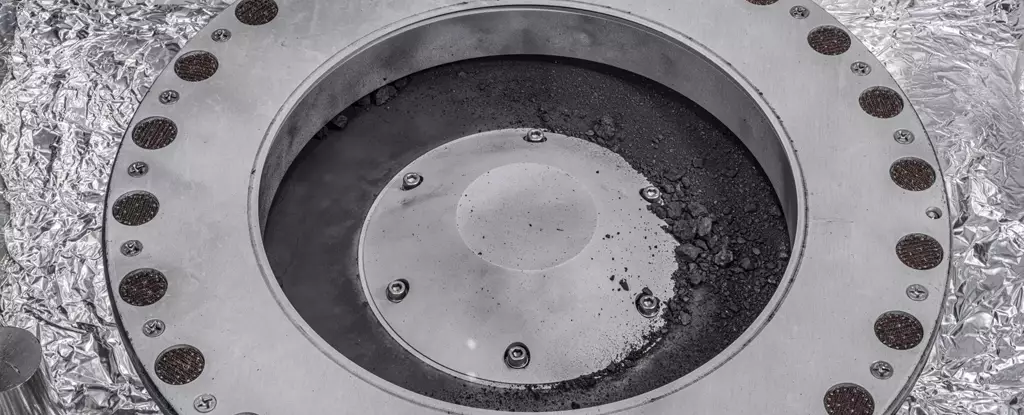In a groundbreaking announcement, NASA revealed that a sample collected from the 4.5-billion-year-old asteroid Bennu contains a significant amount of water and carbon. This discovery adds more weight to the theory that life on Earth was potentially seeded from outer space. The revelation came after the completion of the OSIRIS-REx mission, a seven-year journey to Bennu, which culminated in the delivery of this precious payload in the vast Utah desert. During a press event at the Johnson Space Center in Houston, the first images of black dust and pebbles from Bennu were showcased, leaving scientists astounded by what they found.
Analyzing the sample, scientists discovered that carbon accounted for nearly five percent of its total weight. More remarkably, this carbon existed in both organic and mineral form. Carbon is the building block of life on Earth, forming essential bonds with other elements to create proteins, enzymes, and the foundation of our genetic code—DNA and RNA. Furthermore, water was found to be locked within the crystal structure of clay minerals. These findings give credence to the belief that Earth’s oceans, lakes, and rivers owe their existence to water-carrying asteroids that bombarded our planet approximately 4 to 4.5 billion years ago, rendering it habitable.
The in-depth examination of the asteroid sample involved cutting-edge scientific techniques such as scanning electron microscopy and X-ray computed tomography. This preliminary analysis provided valuable insights into the composition of the sample. Scientists marveled at the significance of the findings, with Daniel Glavin stating, “This stuff is an astrobiologist’s dream.” However, the excitement didn’t stop there, as this sample of Bennu will be shared with laboratories worldwide for further research. Collaborative efforts across the scientific community will undoubtedly lead to even more remarkable revelations.
Unveiling Bennu: A Primordial Artifact in Space
Bennu, aptly named after an ancient Egyptian deity, is hailed as a “primordial artifact preserved in the vacuum of space.” Its allure as a subject of study stems not just from its intriguing composition but also from its orbit intersecting with that of our planet. This proximity made the journey to Bennu comparatively easier than venturing to the Asteroid Belt, situated between Mars and Jupiter. Understanding the composition of Bennu holds potential benefits beyond scientific insights. In the future, this knowledge could prove indispensable if humanity faces the need to avert a collision with the asteroid.
The discovery of water and carbon on Bennu holds profound astrobiological implications. If life on Earth was indeed seeded from outer space, as the theory proposes, then the presence of these critical elements on asteroids like Bennu becomes crucial. These findings open up exciting possibilities for further exploration of other celestial bodies and increase the chances of finding potential signs of life beyond our planet.
The OSIRIS-REx spacecraft encountered unexpected challenges during its mission. While attempting to collect material from Bennu, a flap meant to seal the sample became wedged open, leading to the escape of some of the material into another compartment. However, this fortuitous “problem” enables scientists to study additional “bonus particles” that lay on top of the primary sample-collecting mechanism. The remaining part of the sample will undergo inspection later, allowing for a more comprehensive analysis.
NASA has planned for the extensive preservation of at least 70 percent of the Bennu sample at the Johnson Space Center in Houston. This practice of preserving samples for future study mirrors the precedent set during the Apollo era with Moon rocks. Keeping the samples available for new questions, novel techniques, and emerging instrumentation is essential for ongoing research and discovery. Additional pieces of the sample will be sent for public display at esteemed institutions such as the Smithsonian Institution, Space Center Houston, and the University of Arizona.
The astonishing discovery of water and carbon on asteroid Bennu opens up a new chapter in our understanding of the origin of life. The findings from the OSIRIS-REx mission highlight the significant role that asteroids may have played in the development of habitable conditions on Earth. The study of Bennu provides invaluable insights into the potential for life beyond our planet and sets the stage for future exploration and exciting possibilities. As scientists continue to unravel the mysteries of our universe, each new discovery brings us closer to understanding our place in the cosmos.



Leave a Reply